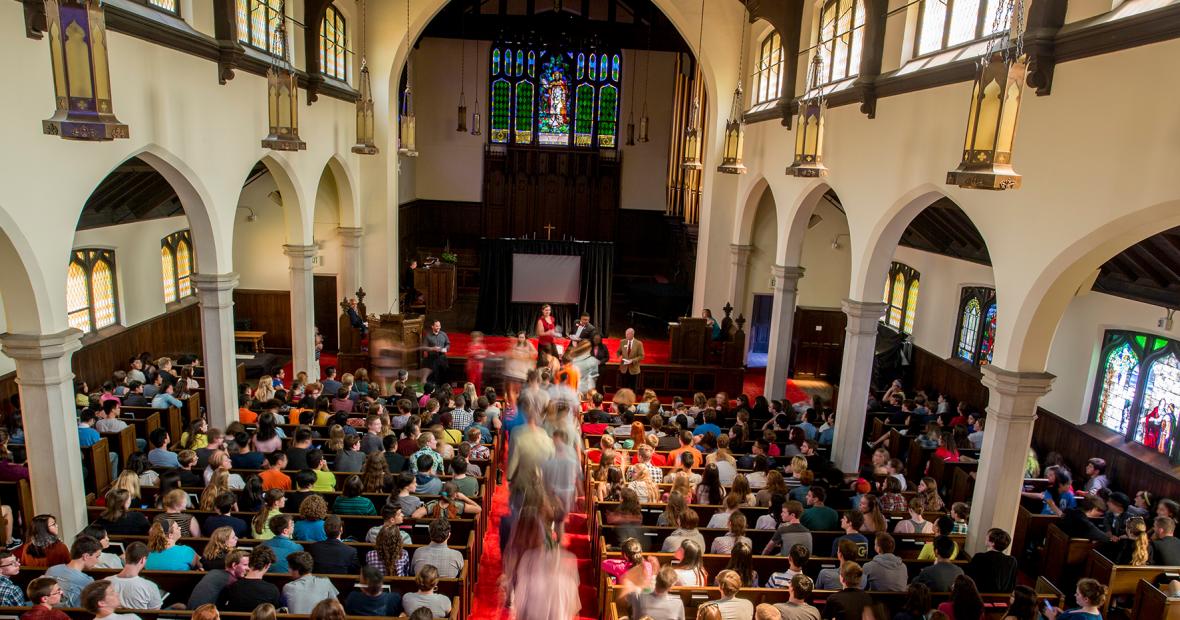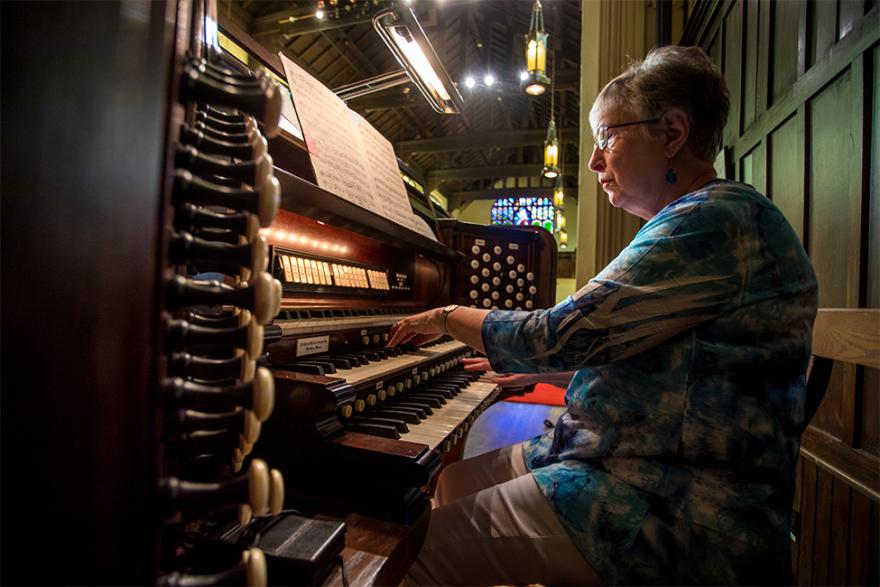Improving Accessibility for People with Hearing Loss
The benefits of hearing loops on campus
Claire Forrest ’13
Until Grinnell College installed a hearing loop in Herrick Chapel, Linda Bryant, the College’s organist, used her smartphone to turn off her hearing aids before performing so that the overtones from the organ didn’t cause unpleasant sensations in her ears.
“I then used the phone to turn them on when people were speaking, but I heard mumbling and only understood a word here or there. That meant I was always guessing when it was time for me to play at the end of a ceremony or worship service, and hoping I got it right,” she says. “When people were speaking at the pulpit or anywhere in front of me, I could not understand what they were saying. I thought it was the way things were.”
Thanks to the work of Juliette Sterkens and the College Accessibility Committee, things aren’t that way anymore. Sterkens, a Wisconsin audiologist and the Hearing Loss Association of America’s hearing loop advocate, visited campus in the fall of 2015. She delivered a lecture on hearing loop technology and advised on where hearing loops might be installed on campus.
A hearing loop is a wire, or an array of wires, that encircles a space and connects to the sound system. The loop transmits the sound electromagnetically to the telecoil (T-coil) in a person’s hearing aid or cochlear implant. If a hearing device does not contain a T-coil, there is an option to wear earbuds connected to a “loop listener” device. Portable loops also exist, allowing the benefits of a looped room within a few feet of the box.
Installation of hearing loops is complete in parts of the Charles Benson Bear ’39 Center for Recreation and Athletics, Burling Library, Joe Rosenfield ’25 Center, Robert N. Noyce ’49 Science Center, Harris Center cinema, and Herrick Chapel. Countertop hearing loops have been installed at the P-Card office, the entrance to the Marketplace, Pioneer Bookshop, conference operations, and the Bear Center information desk.
The College also uses portable loops for Commencement and Faulconer Gallery talks and has small ones available for checking out from the Office of Accessibility and Disability Resources and the Center for Religion, Spirituality, and Social Justice.
Sterkens notes that people who use hearing aids hear best when they are close to the source of the speech signal, when there is minimal background sound, and when they are able to see the person speaking. When the conditions are less than ideal, the user’s ability to hear is compomrised. More technologically advanced hearing aids do not improve these conditions, since all microphones inside the aids have a limited effective range. When a user turns up the volume on the hearing instruments, the background noise will become louder. Hearing loops deliver sound directly to the hearing aid without the deleterious effects of distance and background noise, and the user enjoys hearing speech with great clarity.
With a hearing loop, Sterkens says that in effect, “The microphone on the lectern becomes the microphone for the hearing aid.” Other common types of hearing technology, FM and infrared, are essentially unusable for a person with hearing aids, since they require the wearing of earbuds. Because a hearing loop connects with the telecoil in a person’s hearing aid, cochlear implant, or “loop listener” (a box with earbuds that pick up the electromagnetic waves clearly), the delivered sounds are perfectly customized to a person’s specific hearing loss every time.
As Bryant prepared to play at a ceremony in Herrick Chapel in the fall of 2016, she removed her hearing aids, replaced them with the earbuds, and activated the loop listener box to pick up the hearing loop. The results blew her away.
“For the first time, I understood President [Raynard S.] Kington. I understood everything. The difference was magnificent. It took the uncertainty out of the situation.” She was also relieved the organ kept her out of view. “I was sitting there with tears running down my face. It was just really exciting.”
Grinnell resident J.R. Paulson shares in the excitement. A physician of 35 years, Paulson is a hearing aid user himself and attended Sterkens’ lecture on campus. “I learned a number of things that I didn’t know as a physician and had never learned in medical school.”
He is able to determine a major difference in sound quality if a room is looped or if it is not. He encourages his patients to try it for themselves. “Whether it’s our schools, churches, or business venues, every place it’s happened, it’s been remarkable.”
Advocates on campus hope that hearing loops will be installed in more locations in the future.
Hearing loops provide easy listening that is dignified and free of fuss, and are not just for those with hearing loss. A study conducted at the University of Northern Illinois revealed students who did not have hearing loss enjoyed wearing the earbuds and loop box — which can be controlled using a smartphone — to achieve better comprehension in lectures.
Sterkens believes if all people realized how much better they could hear in a loop, everyone would use it. The technology has existed for more than 40 years, but has yet to go mainstream in the United States. “I’m absolutely convinced that this is the way to go for people who are hard of hearing, and the stories that come out prove me right,” she says. “When Grinnell does this, they raise the bar for other colleges.”
As for Bryant, she’s looking forward to her next performance. “When you live with hearing loss, you don’t know what you’re missing,” she remarks. “You don’t know there’s something that can fix it, so you learn to live with it. In this case, it was fixable. I’m very grateful the College chose to fix it.”


